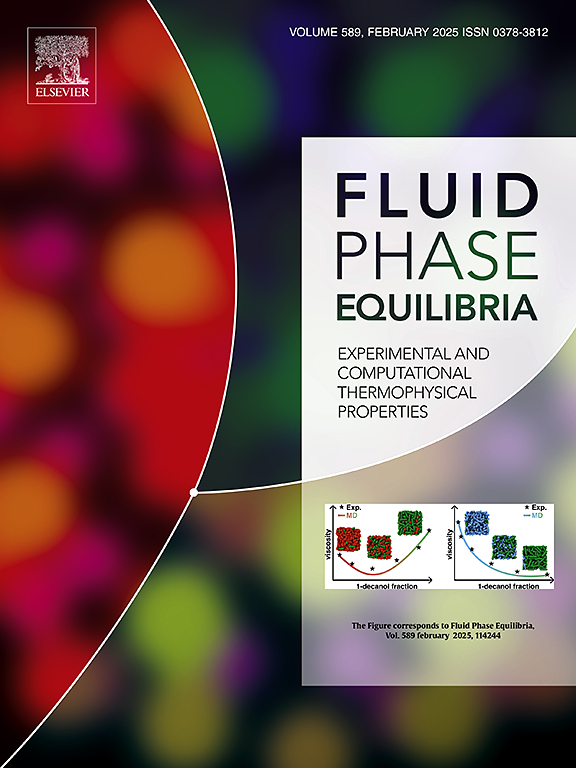The deviation from ideal behavior in mixtures of propylene glycol and propylene carbonate at different temperatures: Experimental results and modeling
IF 2.7
3区 工程技术
Q3 CHEMISTRY, PHYSICAL
引用次数: 0
Abstract
The molecular interactions within a liquid mixture reflect the degree of nonideality present in the solution. This nonideality can be evaluated through various solution properties, including density, viscosity, and refractive index. A comprehensive analysis of these properties offers valuable insights into the interactions between molecules in the mixture. The advancement of models and the validation of theories depend on the precision of these interpretations. This study presents experimental data on the density, refractive index, kinematic viscosity, and dynamic viscosity of a binary liquid mixture comprising propylene glycol and propylene carbonate. The experiments cover a complete range of solution mole fractions at different temperatures. Density data were correlated using the Peng-Robinson and CPA equations of state, yielding binary interaction parameters. The Eyring equation, combined with the NRTL activity coefficient model, was used to correlate kinematic viscosity data, also resulting in binary interaction parameters. Furthermore, the predictive capability of the Lorentz-Lorenz N-mixing rule was assessed for the refractive index data. The deviations from ideal behavior, as indicated by excess molar volume, variations in viscosity, and changes in refractive index, can be attributed to the formation and breaking of hydrogen bonds between the molecules of propylene glycol. The models employed demonstrate a strong capacity to accurately represent the experimental data.
丙二醇和碳酸丙烯酯混合物在不同温度下的理想行为偏差:实验结果和模型
液体混合物中的分子相互作用反映了溶液中存在的非理想性的程度。这种非理想性可以通过各种溶液性质来评估,包括密度、粘度和折射率。对这些性质的全面分析为了解混合物中分子之间的相互作用提供了有价值的见解。模型的发展和理论的验证取决于这些解释的准确性。本研究提出了密度、折射率、运动粘度和动态粘度的实验数据的二元液体混合物,包括丙二醇和碳酸丙烯酯。实验涵盖了不同温度下溶液摩尔分数的完整范围。密度数据使用Peng-Robinson和CPA状态方程进行关联,得到二元相互作用参数。结合NRTL活度系数模型,利用Eyring方程对运动粘度数据进行关联,得到二元相互作用参数。此外,还评估了Lorentz-Lorenz n混合规则对折射率数据的预测能力。过量摩尔体积、粘度变化和折射率变化所表明的与理想行为的偏差,可归因于丙二醇分子间氢键的形成和断裂。所采用的模型显示出较强的准确表征实验数据的能力。
本文章由计算机程序翻译,如有差异,请以英文原文为准。
求助全文
约1分钟内获得全文
求助全文
来源期刊

Fluid Phase Equilibria
工程技术-工程:化工
CiteScore
5.30
自引率
15.40%
发文量
223
审稿时长
53 days
期刊介绍:
Fluid Phase Equilibria publishes high-quality papers dealing with experimental, theoretical, and applied research related to equilibrium and transport properties of fluids, solids, and interfaces. Subjects of interest include physical/phase and chemical equilibria; equilibrium and nonequilibrium thermophysical properties; fundamental thermodynamic relations; and stability. The systems central to the journal include pure substances and mixtures of organic and inorganic materials, including polymers, biochemicals, and surfactants with sufficient characterization of composition and purity for the results to be reproduced. Alloys are of interest only when thermodynamic studies are included, purely material studies will not be considered. In all cases, authors are expected to provide physical or chemical interpretations of the results.
Experimental research can include measurements under all conditions of temperature, pressure, and composition, including critical and supercritical. Measurements are to be associated with systems and conditions of fundamental or applied interest, and may not be only a collection of routine data, such as physical property or solubility measurements at limited pressures and temperatures close to ambient, or surfactant studies focussed strictly on micellisation or micelle structure. Papers reporting common data must be accompanied by new physical insights and/or contemporary or new theory or techniques.
 求助内容:
求助内容: 应助结果提醒方式:
应助结果提醒方式:


